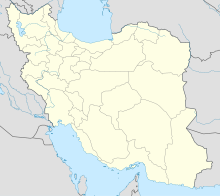Lak (people)
The Lak , Alak or Lek are a Lurian tribe or the southeastern group of Kurdish tribes in Kermanshah , Lorestan , Elam and Hamadan .
Their settlement area is sometimes also called Lakistan ( German Land of the Laks ). Laki is a language of speech categorized as a dialect of Luric or a dialect of southern Kurdish .
history
The name Lak could be derived from the Persian numeral lak (لك) originate for hundreds of thousands and thus denote the original number of Lak families. The Laks are historically important insofar as the dynasty of the Zand princes , who ruled Iran in the 18th century, is of Lacian origin. History shows that the Laks immigrated from the north to their current settlement area. According to the author Rabino, the Laks were settled there on the orders of Shah Abbas .
Web links
- Lak (people) . In: Ehsan Yarshater (Ed.): Encyclopædia Iranica (English, including references)
Individual evidence
- ↑ ایزدپناه ، ح. فرهنگ لکی ، مؤسسه فرهنگی جهانگیری ، تهران ۱۳۶۷ خ ، ص ده (مقدمه)
- ^ The Lurs of Iran. Cultural Survival, March 1985, accessed September 21, 2015 .
- ↑ امان الاهی بهاروند ، سکندر. قوم لر. تهران: آتیه ، 1393
- ^ EJ Anonby: Kurdish or Luri? Laki's Disputed Identity in the Luristan Province of Iran . In: Kurdische Studien , 4 / 1-2, 2004, pp. 5–20.
- ↑ S. Amanolahi: Reza Shah and the Lurs: The Impact of the Modern State on Lorestan . In: Iran & the Caucasus , 6 (1/2), 2002, pp. 193-218, JSTOR 4030721
- ↑ Erik John Anonby: Update on Luri: How many languages? In: Journal of the Royal Asiatic Society (Third Series), 13, 2003, pp. 171-197, doi: 10.1017 / S1356186303003067.
- ^ William J. Frawley, William Frawley: International Encyclopedia of Linguistics & 4-Volume Set, Volume 1. Oxford University Press, 2003, ISBN 978-0-19-513977-8 , p. 310.
- ^ Albrecht Klose: Languages of the World . De Gruyter, 2001, ISBN 978-3-598-11404-5 , p. 227.
- ↑ B. Grimes (ed.): Luri . In: Ethnologue . 13th edition. Dallas 1996, p. 677. M. Ruhlen: A Guide to the World's Languages . Stanford 1991, p. 327.
- ↑ See specified web link
